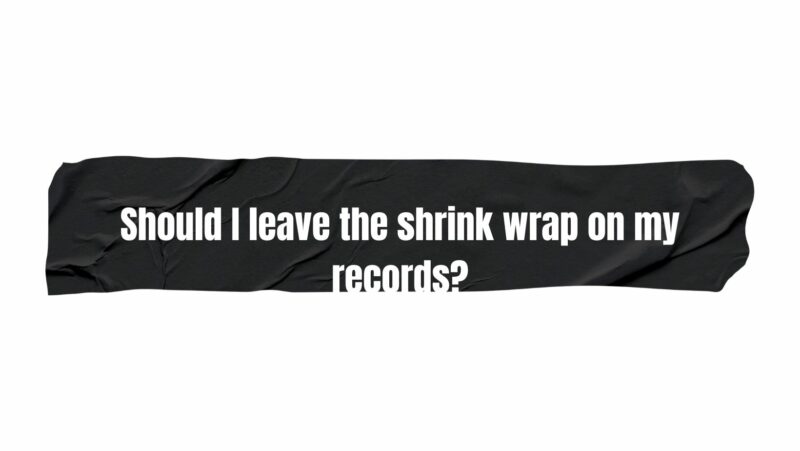The resurgence of vinyl records in the modern era has sparked a renewed appreciation for the tactile and authentic listening experience they offer. As vinyl enthusiasts amass their collections, questions arise about the best practices for preserving the quality and value of these cherished musical artifacts. A topic that frequently ignites debate among collectors is whether to leave the shrink wrap on records. In this comprehensive exploration, we will delve into the discourse surrounding the choice of retaining shrink wrap on vinyl records, analyzing the potential benefits, drawbacks, and expert insights to offer a well-rounded understanding of whether this practice enhances or diminishes the vinyl collecting experience.
Understanding Shrink Wrap on Vinyl Records
Shrink wrap, a thin plastic film that is heat-sealed around a product’s packaging, is commonly used to protect various goods, including vinyl records. Vinyl records are often shrink-wrapped during manufacturing to shield them from dust, moisture, and potential handling damage during shipping and storage. The decision to keep or remove shrink wrap after purchasing a vinyl record is a multifaceted consideration that can impact preservation, authenticity, and even collectibility.
The Pros of Leaving Shrink Wrap Intact
- Preserving Mint Condition: One of the primary arguments in favor of leaving shrink wrap on records is the preservation of mint condition. Shrink wrap acts as a protective barrier, shielding the record cover and vinyl surface from potential dust, dirt, and other environmental contaminants that could degrade their quality over time.
- Collectibility and Authenticity: For collectors who value the potential future value of their records, an unopened, shrink-wrapped album can serve as a testament to the record’s authenticity. This is particularly significant for limited-edition releases, rare pressings, or records with original promotional materials and stickers intact.
- Value Retention: Records with their shrink wrap intact are often perceived as more valuable within the collector community. The packaging’s untouched state can contribute to the record’s overall visual appeal and allure for potential buyers.
- Protection from Handling: Leaving shrink wrap on a record offers added protection against handling damage during transport, storage, or when moving the collection.
The Cons of Keeping Shrink Wrap Intact
- Potential for Warping: Over time, temperature fluctuations and humidity can lead to vinyl records warping. If the shrink wrap is too tight, it may exacerbate the potential for warping by restricting the record’s natural expansion and contraction.
- Off-Gassing: Some shrink wrap materials can release volatile organic compounds (VOCs) that might interact with the record’s cover or vinyl surface. This interaction could lead to discoloration or other forms of damage.
- Adhesion Issues: Shrink wrap can adhere tightly to the record cover, potentially causing adhesion issues. If the shrink wrap is not removed with care, it may cause unintended damage to the cover art.
Expert Opinions and Insights
- Industry Experts: Professionals within the vinyl industry, including manufacturers and distributors, often recommend removing the shrink wrap from records after purchase. They emphasize that while the initial purpose of the shrink wrap is protection during shipping, proper storage conditions are far more critical for maintaining a record’s long-term quality.
- Collector Community: Among collectors, opinions vary widely. Some collectors prioritize the preservation of mint condition and perceive leaving shrink wrap on as a beneficial practice. Others advocate for removing shrink wrap to prevent potential long-term issues associated with warping, off-gassing, and adhesion.
- Storage Considerations: Experts highlight the importance of proper storage conditions, regardless of whether the shrink wrap is retained or removed. Controlled temperature and humidity levels play a significant role in ensuring the record’s longevity and quality over time.
Conclusion
The decision of whether to leave the shrink wrap on a vinyl record or remove it is a nuanced choice that depends on the collector’s priorities, preservation goals, and overall collecting philosophy. While leaving shrink wrap on records can help preserve mint condition, contribute to collectibility, and protect against initial handling, potential drawbacks such as warping, off-gassing, and adhesion should also be carefully considered.
In the end, the practice of leaving shrink wrap on records requires a balanced assessment of benefits and risks. Collectors should take into account expert insights, their personal collecting goals, and the broader context of proper storage conditions. Regardless of the decision made, the key to preserving the longevity and value of vinyl records lies in a thoughtful approach to storage, handling, and ongoing care, ensuring that these musical treasures can be enjoyed for generations to come.


